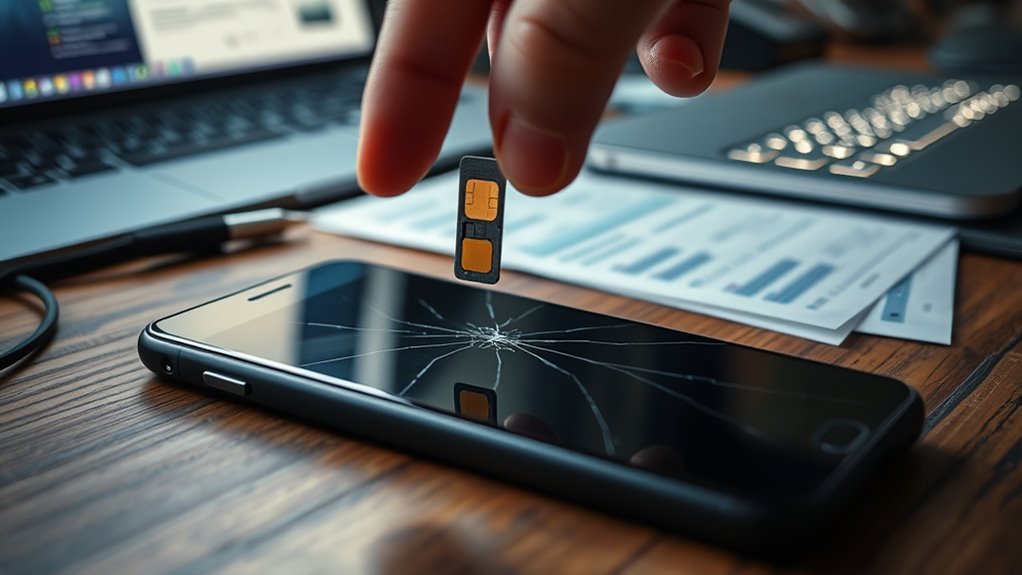SIM swaps let scammers hijack your phone number for just around $100, giving them access to your calls, texts, and private accounts. They trick your carrier into transferring your number to a new SIM, bypassing safeguards and sometimes two-factor authentication. This simple attack can drain your financial and digital life, costing millions in thefts. Stay alert—there’s more to know about protecting yourself from this low-cost but high-impact scam.
Key Takeaways
- SIM swaps allow scammers to hijack phone numbers, enabling access to sensitive accounts and financial information.
- Criminals exploit weak carrier verification processes to transfer phone numbers to new SIM cards.
- The attack can lead to draining bank accounts, stealing cryptocurrencies, and committing identity theft.
- Protect yourself by setting up PINs, monitoring account activity, and using multi-factor authentication methods not reliant on phone numbers.
- Recognizing signs like sudden loss of service and acting quickly can prevent significant financial losses.

SIM swaps are a growing security threat where scammers hijack your phone number by convincing your carrier to transfer it to a new SIM card. Once they succeed, they gain control over your mobile identity, opening the door to a range of malicious activities. This attack can lead to severe consequences, especially if you’re not vigilant about your mobile security. Criminals use SIM swaps not only to intercept your calls and texts but also to access sensitive accounts linked to your phone number, like your email, bank, and social media profiles. These breaches often result in identity theft, where scammers steal your personal information, drain your accounts, and commit fraud in your name.
You might think protecting your phone is enough, but SIM swaps reveal how interconnected your mobile security truly is. If your carrier’s procedures aren’t robust enough to verify your identity during a transfer, scammers can exploit that weakness. Once they have your number, they can reset passwords, bypass two-factor authentication, and impersonate you online. This makes it easier for them to access financial accounts, steal your money, or even sell your personal data on the dark web. Protecting your mobile security means more than just setting a passcode; it requires understanding how vulnerable your phone number can be and taking steps to secure it.
Being proactive is vital. Start by setting up account PINs or additional verification measures with your carrier to prevent unauthorized SIM swaps. Regularly monitor your phone activity and alert your provider immediately if you notice unusual behavior or if your number stops working unexpectedly. Consider using multi-factor authentication methods that don’t rely solely on your phone number, such as authenticator apps or hardware tokens. These measures can make it considerably harder for scammers to take control of your digital identity.
Additionally, understanding how Self Watering Plant Pots work can serve as a reminder about the importance of secure systems—just as these pots maintain optimal moisture levels through a reservoir, your mobile security should have layered defenses to prevent infiltration. Protecting your mobile identity means more than just setting a passcode; it requires understanding how vulnerable your phone number can be and taking steps to secure it. Remember, once your mobile number is compromised, your entire online presence might be at risk, making mobile security a top priority.
Educate yourself about the signs of a potential SIM swap. If you suddenly lose service or can’t receive texts or calls, don’t ignore it. Contact your carrier immediately to verify your account status and reinforce your security settings. Staying vigilant and proactive can prevent a $100 hack from turning into a devastating loss. Protecting your identity from theft starts with securing your mobile identity—and that begins with understanding the risks of SIM swaps and taking the necessary precautions to safeguard your digital life.
Frequently Asked Questions
How Can I Detect if My SIM Has Been Swapped?
You should stay alert for signs your SIM has been swapped, like sudden loss of service, unexpected texts, or authentication issues. These may indicate social engineering or identity theft attempts. Regularly check your account activity and contact your provider immediately if you notice anything suspicious. Being aware of potential scams helps you prevent unauthorized access and protects your personal info from thieves trying to exploit your phone security.
What Immediate Steps Should I Take After a SIM Swap?
After a SIM swap, you should immediately contact your mobile provider to report the issue and regain control of your account. Then, change all your passwords, especially for banking and email accounts, to prevent identity theft and financial fraud. Monitor your bank and credit card statements closely for suspicious activity. Consider placing a fraud alert or freeze on your credit reports to further protect yourself from unauthorized access and potential scams.
Are Certain Phone Carriers More Vulnerable to SIM Swaps?
Some carriers are more vulnerable to SIM swaps due to weaker security measures, so you should research their carrier vulnerabilities before choosing one. Carriers with stronger security protocols, like multi-factor authentication and proactive fraud detection, offer better protection. You can also call your provider to ask about their carrier security practices and consider switching to a carrier that prioritizes security to reduce your risk of being targeted.
Can Two-Factor Authentication Prevent SIM Swap Fraud?
Two-factor authentication can help prevent some scam attempts, but it isn’t foolproof against SIM swap fraud. Your carrier vulnerabilities, like weak security practices, make you more susceptible. To improve scam prevention tips, consider using app-based authenticators instead of SMS codes and setting up account PINs. Always stay vigilant, update your security settings, and be cautious about sharing personal info to protect your accounts from SIM swap scams.
What Legal Recourse Do Victims Have After a SIM Swap Scam?
You want to know what legal remedies and victim support options are available after a SIM swap scam. Victims can file reports with law enforcement, who may pursue criminal charges against scammers. You might also seek civil action for damages. Many organizations offer victim support services, providing guidance and resources to help recover losses and protect your identity. Remember, acting quickly increases your chances of recovering funds and securing your accounts.
Conclusion
You need to stay vigilant because SIM swaps are a real threat. Always enable two-factor authentication, use strong, unique passwords, and be cautious of suspicious messages or calls. Keep your phone’s security settings updated and consider adding extra verification steps with your provider. By staying alert and proactive, you can protect your accounts from falling victim to this costly scam. Don’t let hackers drain your wallet—take action now to secure your digital life.









